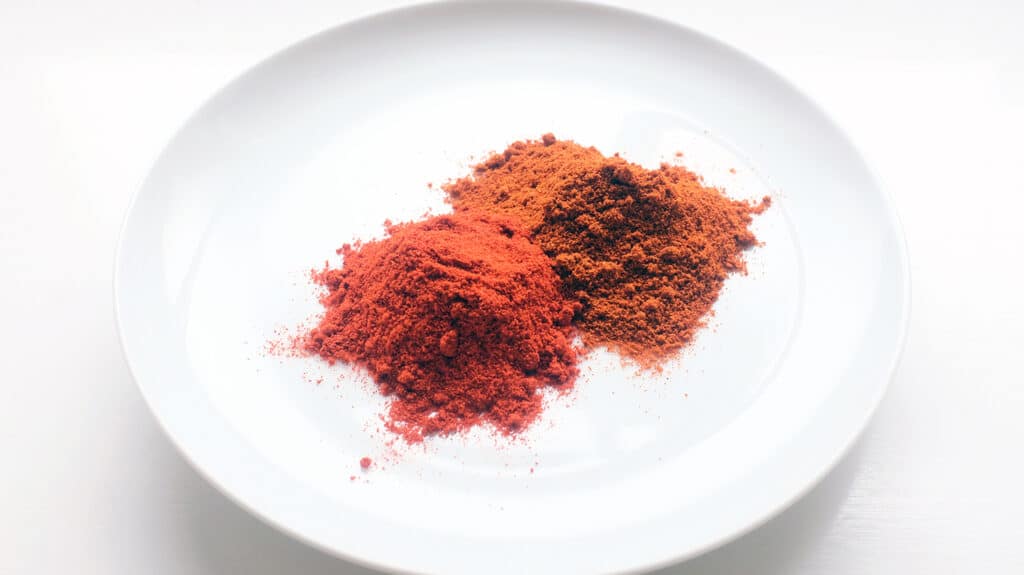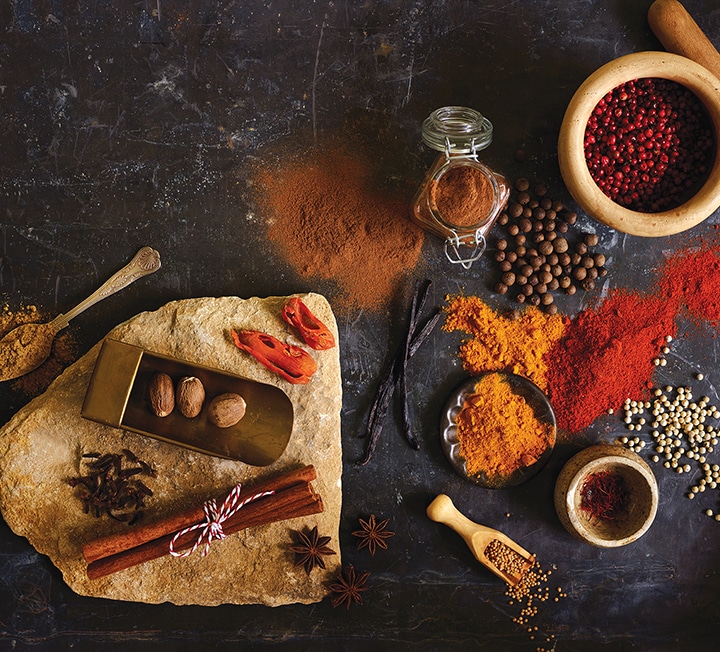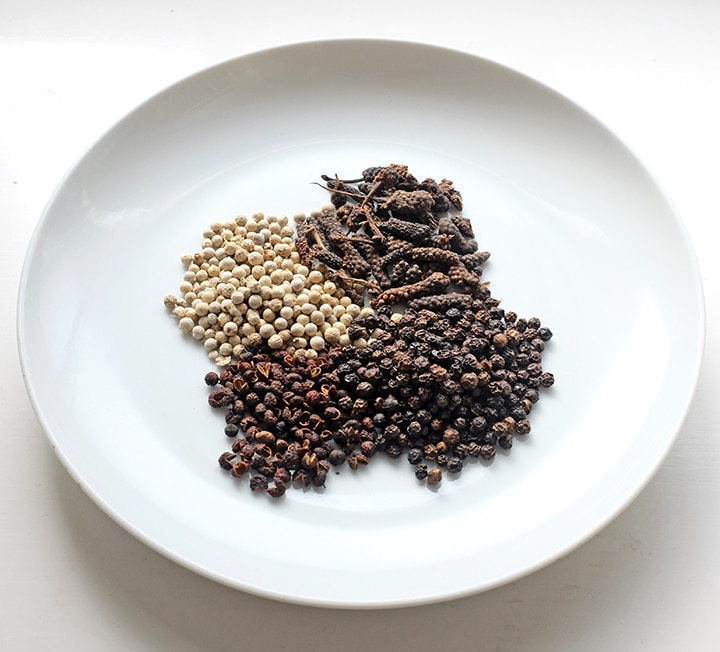The spice series: paprika & cayenne
Ed Smith takes an in-depth look at the many spices available at the Market. This time: paprika and cayenne


“PIMENTÓN BECAME UBIQUITOUS IN SPANISH COOKING – FROM PAELLA, THROUGH PATATAS, CHORIZO, SOBRASADA AND FAR BEYOND”
If you see red in a dish, there’s a good chance it’s thanks to a sprinkle of paprika or cayenne – both of which are dried and ground derivatives of different types of capsicum peppers. Cayenne brings the heat (and is often mixed into paprika to give it a kick). Paprika is often sweet, but ultimately nuanced and varied.
Paprika
As Claudia Roden mentions in her book The Food of Spain, red pepper (and by extraction, paprika) is “the most loved and indispensable of Spanish flavourings”.
The capsicum family is not native to Spain – the seeds having originally been brought back from South America in the 16th century by Franciscan monks, and planted in their monasteries along the Camino de Santiago in northern Spain. Their fruits were soon used in fresh, dry and ground form across Spain, though vast pimentón mills, which produce the fine powder we know now, were more of a 19th century thing. From then (if not before), pimentón became ubiquitous in Spanish cooking – from paella, through patatas, chorizo, sobrasada and far beyond.
Paprika provides colour and flavour and there are four different types of Spanish paprika (known as pimentón): dulce (sweet and mild); agrodolce (bittersweet); picante (hot) and ahumado (smoked). The level of sweet, hot or bitter depends on the specific variety of capsicum being used, though it’s fair to say that it’s always intense and, err, peppery. Any smokiness comes from having been wood-smoked, rather than air-dried.
Different Spanish dishes require different varieties of pimentón, often depending on historic local usage. So when seeing paprika in a recipe, you should always check whether the author meant for it to be sweet, smoky or hot. Note, also, that if you’re after quality, then seek the DOP labelled pimentón de la Vera, which tends to have been smoke-dried, or the more orangey-red pimentón de Murcia, which are sun-dried and sweet.
This intoxicating red powder is not the sole preserve of the Spaniards, though. Hungary counts itself (rightly) as a significant producer and user of paprika. In fact, the British ‘paprika’ comes from the Slavic term for pepper, rather than the Spanish ‘pimentón’, so clearly while not as ancient as the Spanish, the central-eastern European influence over the British use of this spice must be strong.
As a general rule Hungarian paprika is air-dried and sweet, whereas Spanish pimentón tends to be the smoke-dried variety. However, neither country’s red spices are uniform, and happily both Spice Mountain and Brindisa have different grades and varieties, all clearly labelled to suit your requirements.
There’s good advice in the Brindisa cookbook/encyclopedia on both the storage of paprika and how to cook with it. Essentially, the key points are: don’t leave paprika in the back of your cupboard for too long as its aroma and indeed flavour will disappear – the smell “should always overwhelm your senses. If it is dusty or flat it has been sitting on a shelf for too long”; and in terms of cooking, “be careful not to overheat the spice when adding to hot oil as it burns easily and can turn bitter.”
For what it’s worth, 99 per cent of the time, I add paprika to a liquid (into a stock, stew base or sauce). This dissipates the flavour rapidly, and negates the risk of burning. Where that’s not the case (perhaps when slowly sautéing onions, peppers, garlic or all of the above), the heat is gentle and cooking fat and juices relatively plentiful.
Cayenne pepper
As with the peppers used to make paprika, cayenne is a cultivar of capsicum annuum. It’s just that this particular red pepper is a hot one: 30,000-50,000 SHU on the Scoville scale, to be precise. This makes it similar in strength to a tabasco pepper, more than an aleppo pepper or chile de arbor (10,000-30,000 SHU), and less than a habanero or scotch bonnet (100,000-350,000 SHU).
Also, as with paprika, to create the spice, the red chilli fruits, named after the capital of French Guiana, are dried and ground into a powder, or sometimes left coarser, like flakes.
The geographical reference in the name is also an indication that cayenne peppers were originally from the New World, and still tend to prefer warm, subtropical and tropical climates.
Cayenne seems to stand up to hot oil a bit better than paprika, though is still liable to burn and turn acrid, so take care. Take care, too, with quantity: paprika can be generously teaspooned. Cayenne is better suited to a pinch.
Like paprika, you need to keep ground powder in an airtight container, and use before the aroma fades.
Culinary uses
Paprika is often paired with pork, whether in sausages, stews, or sauces. Its sweetness (or sweet and smokiness, where relevant) is also a fine match for eggs, potatoes, tomatoes, or even as another layer of pepperiness for bell or romano peppers.
Other proteins suited to this paprika are chicken, squid, octopus and shellfish – their relative blandness (compared to beef and lamb) are all enhanced by it, without being dominated.
Paprika is, as mentioned, ubiquitous in both Spanish and Hungarian cuisines. There are perhaps too many Spanish dishes that make use of paprika to single out any one of them, but it’s definitely appropriate to whet you whistle with a few of the Hungarian classics: goulash (a rich, meaty, medieval stew); and chicken paprikash, in which the meat simmers in a sauce that begins with a paprika-infused roux.
The Russian dish beef stroganoff is worth mentioning too. Here paprika, sour cream and sautéed beef tend to feature, and then any of mustard, pickles, white wine, brandy, onions and mushrooms find a place too, depending whose instructions you follow.
Cayenne is hot, so it tends to be sprinkled as an additional flourish to a dish, rather than appear as a dominant flavour. It’s also frequently used in spice blends and hot sauces.
This spice is now a global one, and it certainly features in Indian dishes and British ones (devilled kidneys, for example, and often very savoury things involving sharp cheeses, like breads, scones and rarebit).
But cayenne is most notably employed in the cuisines of the Caribbean, from whence it came: of the islands, of Mexico, and of Cajun and Creole cooking in the Deep South of America, whether that’s as a simple seasoning for corn, in addition to lime and butter, or as a kick in gumbo, jambalaya, or the batter mix for deep fried chicken (though apparently the Colonel’s includes paprika, black and white pepper and dried mustard, but not cayenne).
In need of a twist? Perhaps because there’s a natural sweetness to cayenne, it’s sometimes used as a chilli kick to coffee or chocolate desserts, and to cocktails too. Think chocolate pots and bloody marys.
Market spice heroes
I think it’s worth giving a shout out to all the chorizo-style sausages at the Market. There are so many different types of this Spanish sausage: cured, semi-cured, and not cured at all, with multiple regional variations across the country; the one thing uniting them being paprika.
Of course, there are proper Spanish chorizos at Borough, not least in Brindisa’s shop, where fantastic cured and deservedly famous semi-cured cooking sausages stand out. But you’ll also find paprika-fired fresh sausages at Ginger Pig and the large Balkan version of chorizo at Taste Croatia – all of which demonstrate that, as noted above, pork and paprika are a match made in heaven.
Specific recipes to look out for
Paprika and cayenne sit as highly effective seasonings in multiple recipes. However, on occasion, they’re essential and flavour-defining. For example, in:
— A Georgian plum chutney in Olia Hercules’ Mamushka, which requires a fair hit of smoked paprika.
— Claudia Roden’s mojo picon (spicy red sauce) is a mix of cayenne pepper, sweet paprika, cumin, garlic, olive oil and vinegar, and is used to enliven a number of dishes in her seminal book the Food of Spain.
— Monika Linton’s bible Brindisa is rouged with paprika. From simple paprika tumbled potatoes with lardons (you could add a pinch of cayenne to provide a kick), through octopus Galician-style, fried squid with paprika, and rice with chicken, rabbit and paprika – there are many options here.
— Brad McDonald’s book Deep South; New Southern Cooking is loaded with cayenne pepper, not least in his version of the Creole sausage, andouille.
— For devilled kidneys, look no further than Fergus Henderson’s Nose to Tail Eating.
See Ed’s Portuguese-inspired recipe for paprika pork collar and clams.


